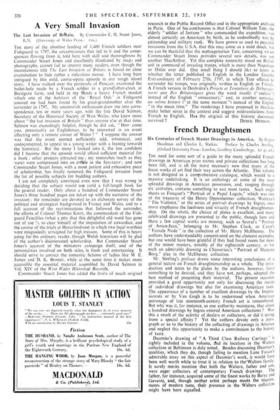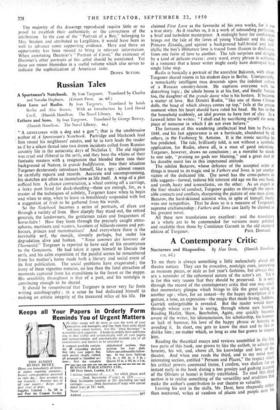French Draughtsmen
Six Centuries of French Master Drawings in America. By Regina Shoolman and Charles E. Slatkin. Preface by Charles Sterling. • (Oxford University Press: London, Geoffrey Cumberlege. La Ss. od.)
THE need for some sort of a guide to the many splendid French drawings in American print rooms and private collections has long been felt, and is all-the more necessary now that many of the finest works of art find their way across the Atlantic. This volume is not designed as a comprehensive catalogue, which would be a massive undertaking. It is an anthology of some of the most splendid drawings in American possession, and, ranging through six centuries, contains something to suit most tastes. Such single sheets as Fouquet's " Portrait of a Papal Legate," which was one of the treasures of the Henry Oppenheimer collection, Watteau's " The Violinist," or the series of portrait drawings by Ingres, once more emphasise the freshness and vivacity of French draughtsman- ship. On the whole, the choice of plates is excellent, and many celebrated drawings are presented to the public, though here and there a few capital works are missing, such as Seurat's " Portrait of Aman-Jean," belonging to Mr. Stephen Clark, or Corot's " Female Nude " in the collection of Mr. Henry Mcllhenny. The authors have understandably concentrated on the choicest examples, but one would have been grateful if they had found room for more of the minor masters, notably of the eighteenth century, or for such an admirable drawing as Chasseriau's " Portrait of Madame Borg," also in the Mcllhenny collection.
Mr. Sterling's preface draws some interesting conclusions of a general nature on French draughtsmanship as a whole. The intro- duction and notes to the plates by the authors, however, leave something to be desired, and they have not, perhaps, adopted the best method of presenting their material. The present occasion provided a good opportunity not only for discussing the merits of individual drawings but also for examining American taste. The appearance of a number of excellent drawings by the Impres- sionists or by Van Gogh is to be understood when American patronage of late nineteenth-century French art is remembered. But why was it, for instance, as one authority maintains, that about a hundred drawings by Ingres entered American collections ? Was this a result of the activity of _dealers or collectors, or did it spring from a special affinity ? Yet the authors devote only a para- graph or so to the history of the collecting of drawings in America and neglect this opportunity to make a contribution to the history of taste.
Dautnier's drawing of " A Third Class Railway Carriage" is rightly included in the volume, hid its location in the Walters collection at Baltimore is duly noted. Besides discussing Daumier's qualities, which they do, though failing to mention Lane Faisan s admirable essay on this aspect of Daumier's work, it would have been well worth while to treat it in relation to the•Walters family. It surely merits mention that both the Walters, father and son, were eager collectors of contemporary French drawings. The father, for instance, acquired some of the finest works by Barye and Gavarni, and, though neither artist perhaps meets the require- ments of modern taste, their presence in the Walters collection might have been signalled. - The majority of the drawings reproduced require little- or no proof to establish their authenticity or the correctness of the attribution. In the case of the " Portrait of a Boy," belonging to Mrs: Stralem and attributed to Largilliere, it would have been as well to advance some supporting evidence., Here and there an opportunity has been missed to bring in relevant information. When annotating Daumier's " Portrait of Corot," the existence of Daumiers other portraits of this artist should be mentioned. Yet these are minor blemishes in a useful volume which also serves to indicate the sophistication of American taste. DENYS SUTTON.







































 Previous page
Previous page